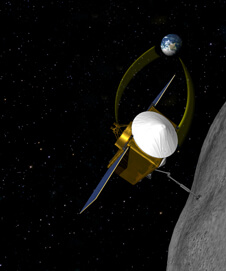NASA has approved the construction of the Osiris Rex spacecraft that will reach a near-Earth asteroid and examine its origin

NASA will launch a spacecraft to an asteroid in 2016 and use a robotic arm to dig up samples that will allow a better understanding of how the solar system formed and how life began. The Osiris Rex Origins-Spectral Interpretation-Resource Identification-Security-Regolith Explorer mission will be the US mission that will take soil samples from an asteroid and bring them to Earth.
"This is a step toward the goal set forth by President Obama to expand our presence beyond low orbit and explore deep space," said NASA Administrator Charlie Bolden. "This is a robotic mission where we pave the way for future manned missions to an asteroid and other deep space targets."
NASA chose Osiris Rex after considering three options for science missions that also included returning a soil sample from the far side of the Moon and a mission to the surface of Venus.
Asteroids are the remnants of the cloud of gas and dust - the solar nebula - that crashed and created the sun and the planets about 4.5 billion years ago. As such they include the original material of the nebula, which can tell us about the conditions that prevailed at the birth of the solar system.
After a four-year journey, Osiris Rex will reach a near-Earth asteroid known as 1999 RQ36 in 2020. After approaching about 5 kilometers from the asteroid, the spacecraft will begin six months of massive mapping of the surface. The scientific team will select a location where the robotic arm will excavate the sample. The spacecraft will gradually approach the asteroid and the arm will extend and collect about 50 grams of materials and bring them to Earth in 2023. The mission, not including the launch vehicle, is expected to cost about 800 million dollars.
The sample will be stored in a capsule that will land in the testing area in Utah. The capsule will be similar to the one used by NASA's Stardate spacecraft that first returned samples from a comet - Wilt 2 - in 2006. The Osiris Rex return capsule will be taken to the Johnson Space Center in Houston. The materials will be transferred to a dedicated research facility according to a protection protocol. The materials will undergo tests that cannot be performed on a spacecraft.
Asteroid RQ36 is a relatively small asteroid. Its diameter is about 600 meters and it has changed a little over time. Therefore, NASA estimates that it may represent a snapshot of our solar system in its infancy. The asteroid is probably rich in carbon, a key component in the organic molecules essential to life.
Organic molecules have so far been found in meteorites and samples from comets, and they indicate that the ingredients for life can form in space. The scientists want to see if they are also in RQ36.

4 תגובות
Sale!
50 grams for 800 million dollars!
only today!
A mission to Jupiter is planned - Juno.
Is it really that important? Isn't it better to invest the money and explore the 4 intriguing moons of Jupiter??
Io, Europa, Gynmede and Callisto.
Our curiosity drives us to know a lot and in a short time.